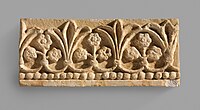Empire of the Iranians | |
|---|---|
| 224–651 | |
Derafsh Kaviani
(imperial standard) Simurgh
(imperial emblem) | |
![The Sasanian Empire at its greatest extent, c. 620, under Khosrow II[citation needed]](http://upload.wikimedia.org/wikipedia/commons/thumb/c/cf/The_Sasanian_Empire_at_its_apex_under_Khosrow_II.svg/250px-The_Sasanian_Empire_at_its_apex_under_Khosrow_II.svg.png) | |
| Capital | |
| Common languages | Middle Persian (official)[2] Other languages |
| Religion | |
| Government | Feudal monarchy[3] |
| Shahanshah | |
• 224–241 | Ardashir I (first) |
• 632–651 | Yazdegerd III (last) |
| Historical era | Late Antiquity |
| 28 April 224 | |
• The Iberian War | 526–532 |
| 602–628 | |
| 628–632 | |
| 633–651 | |
| 651 | |
| Area | |
| 550[5][6] | 3,500,000 km2 (1,400,000 sq mi) |
| History of Iran |
|---|
 |
|
Timeline |
The Sasanian Empire (/səˈsɑːniən, səˈseɪniən/), officially Ērānšahr (Middle Persian: 𐭠𐭩𐭥𐭠𐭭𐭱𐭲𐭥𐭩, lit. 'Empire of the Iranians'),[7][8][a] was the last pre-Islamic Iranian empire. Named after the House of Sasan, it endured for over four centuries, from 224 to 651, making it the second longest-lived Persian imperial dynasty after the directly preceding Arsacid dynasty of Parthia.[10][11] It fell to the Rashidun Caliphate during the early Muslim conquests, which marked the beginning of a monumental societal shift by initiating the Islamization of Iran.
Upon succeeding the Parthians, the Sasanian dynasty re-established the Persian nation as a major power in late antiquity, and also continued to compete extensively with the neighbouring Roman Empire.[12][13][14] It was founded by Ardashir I, a ruler who rose to power as Parthia weakened amidst internal strife and the Roman–Persian Wars. After defeating Artabanus IV of Parthia during the Battle of Hormozdgan in 224, Ardashir's dynasty replaced that of the Arsacids and promptly set out to restore the legacy of the Achaemenid Empire by expanding the newly acquired Sasanian dominions.
At its greatest territorial extent, the Sasanian Empire encompassed all of modern-day Iran and Iraq and parts of the Arabian Peninsula (particularly Eastern Arabia and South Arabia), as well as the Caucasus, the Levant, and parts of Central Asia and South Asia.
One of the high points in Iranian civilization,[15] the Sasanian dynasty's rule was characterized by a complex and centralized government bureaucracy, and also revitalized Zoroastrianism as a legitimizing and unifying ideal.[16] This period saw the construction of many grand monuments, public works, and patronized cultural and educational institutions. The Sasanian Empire's cultural influence extended far beyond the physical territory that it controlled, impacting regions as distant as Western Europe,[17] Eastern Africa,[18] and China and India.[19] It also helped shape European and Asian medieval art.[20]
With the Muslim conquest of Persia, the influence of Sasanian art, architecture, music, literature, and philosophy was gradually absorbed into nascent Islamic culture, which, in turn, ensured the spread of Iranian culture, knowledge, and ideas throughout the expanding Muslim world.[21]
- ^ "Ctesiphon – Encyclopaedia Iranica". Iranicaonline.org. Retrieved 16 December 2013.
- ^ Daryaee 2008, pp. 99–100.
- ^ First Encyclopaedia of Islam: 1913–1936. Brill. 1993. p. 179.
- ^ Pourshariati 2008, p. 4.
- ^ Turchin, Peter; Adams, Jonathan M.; Hall, Thomas D (December 2006). "East-West Orientation of Historical Empires". Journal of World-Systems Research. 12 (2): 223. ISSN 1076-156X. Retrieved 11 September 2016.
- ^ Taagepera, Rein (1979). "Size and Duration of Empires: Growth-Decline Curves, 600 B.C. to 600 A.D.". Social Science History. 3 (3/4). p. 122. doi:10.2307/1170959. JSTOR 1170959.
- ^ Canepa 2018, p. 9.
- ^ Daryaee 2018, p. 1.
- ^ MacKenzie, D. N. (2005), A Concise Pahlavi Dictionary, London & New York: Routledge Curzon, p. 120, ISBN 978-0-19-713559-4
- ^ (Wiesehöfer 1996)
- ^ "A Brief History". Culture of Iran. Archived from the original on 21 November 2001. Retrieved 11 September 2009.
- ^ (Shahbazi 2005)
- ^ Norman A. Stillman The Jews of Arab Lands p. 22 Jewish Publication Society, 1979 ISBN 0827611552
- ^ International Congress of Byzantine Studies Proceedings of the 21st International Congress of Byzantine Studies, London, 21–26 August 2006, Volumes 1–3 p. 29. Ashgate Pub Co, 2006 ISBN 075465740X
- ^ Hourani, p. 87.
- ^ Eiland, Murray (2004). "West Asia 300 BC–AD 600". In Onians, John (ed.). Atlas of World Art. Oxford University Press. pp. 80–81. ISBN 978-0195215830.
- ^ Durant, Will (1950). The Age of Faith. p. 150.
Repaying its debt, Sasanian art exported its forms and motives eastward into India, Turkestan, and China, westward into Syria, Asia Minor, Constantinople, the Balkans, Egypt, and Spain.
- ^ "Transoxiana 04: Sasanians in Africa". Transoxiana.com.ar. Retrieved 16 December 2013.
- ^ Sarfaraz, pp. 329–330
- ^ "Iransaga: The art of Sassanians". Artarena.force9.co.uk. Retrieved 16 December 2013.
- ^ Abdolhossein Zarinkoob: Ruzgaran: tarikh-i Iran az aghz ta saqut saltnat Pahlvi, p. 305
Cite error: There are <ref group=lower-alpha> tags or {{efn}} templates on this page, but the references will not show without a {{reflist|group=lower-alpha}} template or {{notelist}} template (see the help page).

